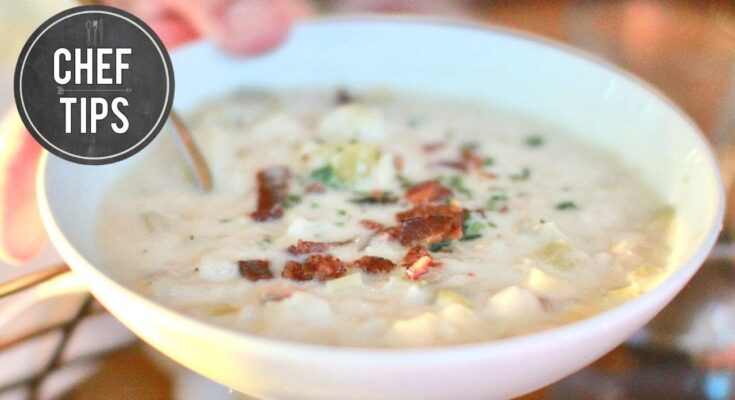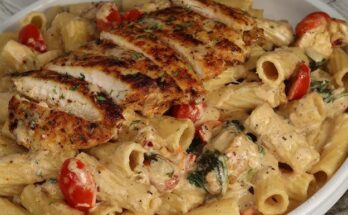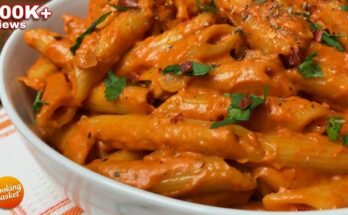Salmon Chowder Recipe: Salmon chowder is one of those heartwarming, creamy soups that screams comfort food. Think of it like a hug in a bowl. It’s packed with tender salmon, soft potatoes, sweet corn, and all the comforting flavors you can imagine, bound together with a creamy broth that’s rich without being heavy. Whether you’re coming in from a cold day or just looking for something satisfying, salmon chowder has that cozy, soul-soothing effect.
You’ll love how this dish is both luxurious and down-to-earth at the same time. It’s often made in big batches, perfect for family dinners, meal prep, or freezing for future comfort meals. And what’s even better? It’s super adaptable. Want to go dairy-free? No problem. Prefer it chunky or smooth? You do you.
History and Origins
Chowders have been around for centuries, originally developed in fishing communities along the Atlantic coast. The word “chowder” is thought to come from the French word “chaudière,” a type of cooking pot used by fishermen. These stews would typically be made with the catch of the day, and as salmon became more popular and accessible, it naturally found its way into this creamy concoction.
Salmon chowder likely has its roots in the Pacific Northwest where salmon is abundant and loved. Over time, it’s evolved with regional twists—some versions include bacon, others add dill or lemon, but the essence remains the same: warm, hearty, and incredibly flavorful.
Ingredients You’ll Need
Fresh vs Canned Salmon
Let’s talk fish. You can use either fresh or canned salmon, and both have their perks. Fresh salmon gives a more refined, delicate texture, and if you’re lucky enough to have leftovers from grilled or baked salmon, this is a great way to repurpose them.
Canned salmon, on the other hand, is super convenient. It’s shelf-stable, affordable, and still delicious. Just be sure to remove any skin or bones if you’re not a fan of the extra bits. Wild-caught Alaskan salmon is often the best bet if you’re going the canned route—packed with nutrients and full of flavor.
Here’s a quick comparison:
| Feature | Fresh Salmon | Canned Salmon |
|---|---|---|
| Texture | Flaky, tender | Softer, mushier |
| Flavor | Mild, buttery | Stronger, briny |
| Prep Time | Needs cooking | Pre-cooked |
| Cost | More expensive | Budget-friendly |
| Shelf Life | Short | Long |
Essential Vegetables and Herbs
A classic salmon chowder starts with a medley of basic but flavorful vegetables:
- Onions – yellow or white for sweetness
- Celery – adds crunch and depth
- Carrots – natural sweetness to balance the briny salmon
- Potatoes – russet or Yukon Gold work best for that creamy, soft texture
- Corn – frozen or fresh kernels give bursts of sweetness
For herbs, don’t skip these:
- Bay leaf – adds that subtle background flavor
- Thyme – earthy and aromatic
- Dill – optional, but pairs beautifully with salmon
Salt, pepper, and a dash of paprika or Old Bay seasoning can take your chowder from good to restaurant-worthy.
Best Dairy Options for Creaminess
Dairy is what transforms a chunky fish soup into a chowder. You want something that brings creaminess without overpowering the other ingredients.
Here are the best options:
- Heavy cream – ultra-rich and indulgent
- Half-and-half – a lighter choice that still delivers creaminess
- Whole milk – okay in a pinch, but less luxurious
- Cream cheese – not traditional, but can add tang and richness
If you’re dairy-free, coconut milk or a cashew cream base can work too. Just be sure to adjust the flavor with extra herbs and maybe a squeeze of lemon to balance things out.
Kitchen Tools and Prep Tips
Tools Required
Don’t worry, you don’t need a high-end kitchen setup for this one. Most of what you need is probably already in your cabinets:
- Large pot or Dutch oven
- Cutting board and sharp knife
- Wooden spoon or spatula
- Measuring cups and spoons
- Ladle for serving
Optional but helpful:
- Immersion blender (if you want a smoother texture)
- Potato masher (to break up some of the potatoes and thicken the soup naturally)
How to Prep Ingredients Efficiently
The key to a smooth cooking experience is prepping everything before you start. Here’s a smart prep order to follow:
- Chop all your veggies – onions, carrots, celery, and potatoes. Keep them in separate bowls so you can toss them in when needed.
- Measure your spices and herbs – this saves time when you’re in the heat of cooking.
- Flake your salmon – if using canned, drain and break it up. If using fresh, cook and shred in advance.
- Warm your broth and dairy – bringing these to room temp or warming slightly can prevent curdling when added to the hot pot.
This bit of prep upfront makes the actual cooking process a breeze. Trust me, you’ll thank yourself later.
Step-by-Step Cooking Process
Step 1 – Sautéing the Aromatics
First things first—flavor starts in the base. Get your large pot or Dutch oven hot over medium heat and add a generous pat of butter or a couple of tablespoons of olive oil. This fat will carry all the flavors you’re about to build.
Toss in your chopped onions, celery, and carrots. These three are the holy trinity of soups and stews. Let them cook down until they’re soft and translucent—this usually takes about 7 to 10 minutes. Stir occasionally so nothing sticks or browns too much. You’re aiming for softness and aroma, not caramelization.
Once they’re softened, sprinkle in your minced garlic and dried herbs like thyme and a bay leaf. Stir and let everything sizzle for another minute. This stage is all about unlocking those hidden flavors and infusing your chowder with a rich, savory base that will set the stage for everything else.
Season lightly with salt and pepper. Don’t go heavy yet—you’ll adjust later once all the ingredients are in the pot. Sautéing these aromatics right is the secret behind a chowder that tastes like it simmered for hours—even if you whip it up in under 45 minutes.
Step 2 – Adding Broth and Potatoes
Now it’s time to build the body of your chowder. Add your chicken or seafood broth to the pot, stirring to deglaze the bottom—this just means loosening all those tasty browned bits stuck to the pan.
Bring the broth to a simmer, then toss in your chopped potatoes. These will need to cook for about 15–20 minutes, depending on the size of your cubes. The key here is to make sure the potatoes are tender but not mushy. A fork should glide in with a little resistance.
While the potatoes are cooking, you can add a bit of seasoning—maybe some paprika or Old Bay to punch things up. Some folks even throw in a small splash of white wine for a hint of acidity. This is also the perfect time to toss in your corn if you’re using frozen or fresh kernels.
As the potatoes soften, the starch starts to thicken the soup naturally. If you like your chowder thick and hearty, you can mash a few of the cooked potatoes right in the pot with the back of a spoon. Instant creaminess without adding flour or thickeners!
Step 3 – Cooking the Salmon
With your veggies softened and broth bubbling, it’s time for the star of the show—salmon. If you’re using fresh raw salmon, cut it into bite-sized chunks and gently place them in the pot. Let the salmon poach gently in the hot liquid for 5–7 minutes, or until it turns opaque and flakes easily with a fork.
If you’re using pre-cooked or canned salmon, now’s the time to stir it in. Since it’s already cooked, just give it enough time to heat through—about 3 minutes. Be careful not to over-stir; you want chunks of salmon, not mush.
This is where your chowder starts to really come alive. The salmon infuses the broth with its natural oils and flavor, turning a basic soup into something luxurious and deeply satisfying.
You can also toss in a handful of chopped fresh herbs like dill or parsley at this point if you want a fresh pop of color and flavor.
Step 4 – Cream and Final Touches
This final step transforms your salmon stew into a true chowder. Lower the heat and pour in your cream, half-and-half, or dairy alternative. Stir gently and let the soup simmer for 5 more minutes—but don’t let it boil! High heat can cause the cream to split, which makes your chowder look grainy.
Taste the soup and adjust the seasoning. Need more salt? A pinch of pepper? Maybe a little squeeze of lemon juice to brighten things up? Now’s the time.
If you like your chowder super creamy, go ahead and blend a small portion using an immersion blender right in the pot. Or scoop out a cup, blend it in a regular blender, and stir it back in. This will thicken the chowder without changing the rustic texture too much.
Serve your chowder hot with crusty bread, oyster crackers, or even a sprinkle of shredded cheese on top. Garnish with fresh herbs or a drizzle of olive oil for that final touch of finesse.
Pro Tips to Elevate Your Chowder
Flavor Boosters
Want to make your salmon chowder unforgettable? Here are a few secret weapons:
- A dash of smoked paprika or chipotle powder for a hint of smokiness
- Splash of dry white wine during the sauté stage for acidity
- Clam juice added to your broth for seafood depth
- Lemon zest or juice at the end to brighten everything
- Crumbled bacon for a savory topping that adds crunch and umami
Little things go a long way. You don’t need to do all of these—just pick one or two depending on your mood and what you have on hand.
Texture Tricks
If you want your chowder to feel more luxurious, it’s all about texture. Here’s how:
- Mash some of the potatoes right in the pot—this thickens naturally
- Add a pat of butter right at the end for silkiness
- Use cream cheese in place of part of your cream for tangy richness
- Top with a dollop of sour cream or crème fraîche for contrast
Even the way you cut your veggies matters—bigger chunks make a more rustic chowder, while smaller pieces create a refined feel.
Serving Suggestions for Salmon Chowder
Perfect Pairings for Your Chowder
Once your salmon chowder is ready, serving it right makes all the difference. This creamy soup is hearty enough to be a meal on its own, but pairing it with the right side dish can elevate the entire dining experience.
Here are some classic and creative ideas:
- Crusty Bread or Garlic Toast: You can’t go wrong with a warm, crusty baguette or slices of garlic bread to soak up every last drop of that creamy broth.
- Buttery Crackers or Oyster Crackers: These offer a perfect salty crunch and add a fun texture contrast to the creamy soup.
- Fresh Salad: A light, citrusy salad with arugula, vinaigrette, and maybe some shaved parmesan provides a refreshing counterbalance.
- Grilled Cheese Sandwich: Yes, it might sound indulgent, but dunking a gooey grilled cheese into salmon chowder? Pure comfort.
- Roasted Vegetables: Try some roasted Brussels sprouts or asparagus to keep the meal veggie-forward and a bit lighter.
Don’t forget garnishes like chopped chives, fresh dill, or even a sprinkle of smoked sea salt. These tiny additions add freshness and color to your bowl.
Storing and Reheating Salmon Chowder
How to Keep It Fresh
If you’re lucky enough to have leftovers (or smart enough to make extra), salmon chowder stores beautifully with a few tips to keep it at peak flavor and texture.
Refrigerator Storage:
- Let the chowder cool completely before transferring it to an airtight container.
- It will keep in the fridge for 3 to 4 days.
- Avoid storing it in metal containers; glass or BPA-free plastic is best to preserve flavor.
Freezer Storage:
- Yes, you can freeze chowder—but be aware that dairy can separate a bit upon reheating.
- If planning to freeze, consider holding back on the cream and adding it fresh after thawing.
- Store in individual portions to make reheating quick and easy.
- Chowder will keep frozen for up to 2 months.
Best Reheating Methods
- Stovetop: The best method. Reheat on low to medium heat, stirring occasionally to keep the cream from separating.
- Microwave: Use a microwave-safe bowl. Cover loosely and heat in 1-minute increments, stirring between.
- Avoid Boiling: Too much heat can cause the chowder to curdle or the salmon to overcook and dry out.
If it thickens too much during storage, just add a splash of milk or broth while reheating to get that perfect consistency back.
Nutritional Benefits of Salmon Chowder
Is It Healthy? Let’s Break It Down
While salmon chowder is rich and creamy, it’s also packed with nutrients, especially when made from scratch.
Salmon is a superstar:
- Rich in omega-3 fatty acids, which support brain and heart health
- Loaded with high-quality protein
- Packed with vitamin D, B12, and selenium
Vegetables like carrots, celery, and potatoes bring:
- Fiber
- Antioxidants
- Essential vitamins and minerals
Cream and dairy, while indulgent, offer calcium and energy. If you’re watching calories, swap in lighter dairy options or reduce the cream by half and blend some of the soup for natural thickness.
With a balance of protein, healthy fats, and complex carbs, a bowl of salmon chowder can actually be quite balanced. It’s comfort food with benefits.
Why Homemade is Better Than Store-Bought
Control, Flavor, and Freshness
Store-bought chowders might be convenient, but they often come with a long list of preservatives, excessive sodium, and questionable ingredients.
Making your own gives you full control over:
- Salt levels
- Quality of salmon
- Freshness of vegetables
- Type of dairy used
- Portion sizes
Plus, the flavor difference is massive. Fresh herbs, real cream, and home-simmered broth create a chowder that’s leagues above anything from a can. You’ll also avoid that overly thickened, gelatinous texture many commercial chowders have.
If you’re cooking for someone with allergies or dietary restrictions, homemade is also the safer bet. You can make it gluten-free, dairy-free, or even keto with the right swaps.
FAQs about Salmon Chowder Recipe
1. Can I make salmon chowder without cream?
Yes! You can use coconut milk, almond milk, or a potato-based thickener for a creamy texture without dairy.
2. What type of salmon is best for chowder?
Wild-caught Alaskan salmon is ideal for its flavor and sustainability, but canned pink or sockeye salmon works well too.
3. Can I use frozen salmon?
Absolutely. Just thaw it first, pat it dry, and cook as you would with fresh salmon.
4. Is salmon chowder gluten-free?
This recipe is naturally gluten-free if you avoid flour or use gluten-free thickeners and crackers.
5. How can I make the chowder thicker?
Mash some of the cooked potatoes, add a slurry of cornstarch and water, or blend a portion of the soup for extra creaminess.
Conclusion
Salmon chowder isn’t just a soup—it’s a warm, creamy bowl of comfort that brings together everything you love in a homemade meal. From the tender, flaky salmon to the creamy broth and hearty vegetables, this dish offers a perfect balance of richness and nourishment. It’s easy enough for a weeknight dinner, yet special enough to serve guests or enjoy as a holiday starter.
With the right ingredients, some simple techniques, and a little love, you can whip up a salmon chowder that rivals any restaurant version. So grab your pot, prep your ingredients, and let the aromas fill your kitchen.
And the best part? Once you master this chowder, you’ll find endless ways to tweak it, make it your own, and share it with people you love.



